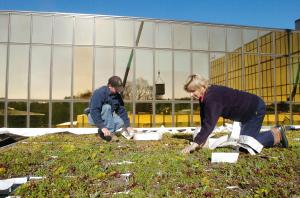
STAMFORD, CT - What if an office building had a roof that filtered water, deflected heat in the summer and kept the building warm in winter? How about if it cleaned the air, too? Those are the environmental benefits office owners said they will be reaping from green roofs, gardens that sit atop buildings specially waterproofed to grow plants. Long before going green became a trend, Stamford land use officials encouraged downtown builders to install green roofs by creating incentives for planting atop parking garages.
Now, builders are bringing a new wave of green roofs to the city, with a focus on saving energy and giving employees a better work environment. The Royal Bank of Scotland, Metro Tower, and High Ridge Park are putting the concept into action. The new Royal Bank of Scotland headquarters downtown will boast over 1 acre of cultivated rooftop, Roger Ferris, architect for the project, said. The building designers opted for an "intensive" green roof layout, with thick soil and trees. Only roofs designed to withstand a great deal of weight can handle intensive plantings.
The terrace-like design means RBS workers can experience the amenity up close. "Employees will be able to go out onto the green roof and enjoy the park-like environment," Ferris said. But the benefits go farther than that. The plants, all native to the region, will help reduce the city's heat island effect and absorb water that can be reused for cooling and irrigation, Ferris said. He likens the system to "a type of biofilter" that can actually remove contaminants from rainwater. Water filters through the layers of soil, gravel and plants, leaving it cleaner. By taking such environmental steps, RBS is being a "responsible world citizen," Ferris said. "It's just the smart thing to do. It's the responsible thing to do," he said.
Intensive is not the only way for office owners to build green roofs. This month in Turn of River, Aleksandra Moch, owner of Green Roof Concepts, planted succulents and bamboo atop a newly built cafeteria in the High Ridge Park office complex. Unlike trees, the plants need little soil or care, Moch said. "It's a very hardy plant," Moch said of the succulents, called sedum. "It's basically care-free."
Mark Rosenstein, director of construction for the office park owner, George Comfort and Sons, said the roof will not be a plaza but a visual amenity for buildings surrounding it. The company footed a bill of about $50,000 for the plantings, but Rosenstein said the investment will be worth it. Not only will the roof save energy and help reduce storm water runoff, it also may lure potential tenants. Since acquiring the High Ridge Park campus, George Comfort and Sons has been sprucing up the buildings, increasing the occupation level from 40 percent to 90 percent, he said. "It just seemed like a natural thing to do," Rosenstein said. "Everyone will be looking down on it and, instead of seeing an ugly roof, they'll see a nice green garden."
The installation was a relatively simple process. To start, workers laid a water-resistant membrane to prevent roof leaks. They added an additional layer, then set trays of drought-resistant sedum plants. The procedure was like sodding grass, the plants came in 1-by-2-foot rectangles. Laid side by side, they grow together. The plants are low-maintenance, said Rich Palmer of Pride's Corner Farm. They need weeding about once or twice a year, and an annual date with a lawn mower will keep them healthy.
The city first incorporated green roofs into downtown zoning requirements in the 1970s as a way to encourage the creation of public spaces and better aesthetics for downtown employees, Land Use Chief Robin Stein said. As a result, there are nearly 14 acres of green roofs downtown.
Soon, a new one may be installed at Metro Tower, the office building W&M Properties plans to build in the South End. The green roof system, incorporated on both the tower and its parking structure, will capture stormwater runoff and reuse it as flush water in bathrooms, said Tom Durels, the firm's executive vice president. The building will also maximize use of natural light, prevent heat transfer, and distribute heating and cooling using a floor system that employees can adjust within their own personal workspace.
Metro Tower is aiming to become the first building to receive the highest green building certification in the state, a platinum-level LEED certification, awarded by the U.S. Green Building Council. Ultimately, creating a better work environment is better business, Durels said. "We think the companies that lease space are very sophisticated," Durels said. "We want to create the healthiest work environment in the state."
Source: StamfordAdvocate.com